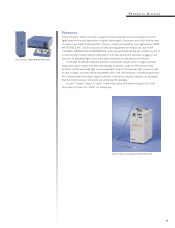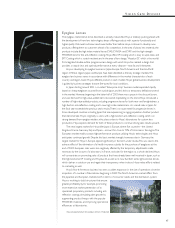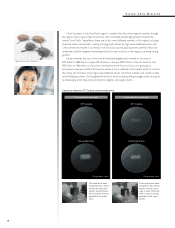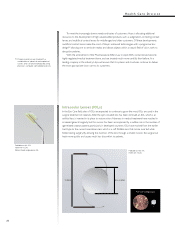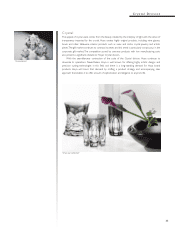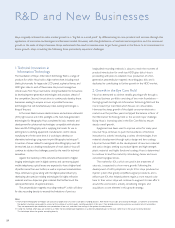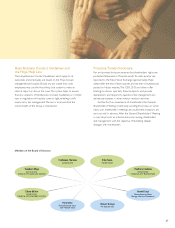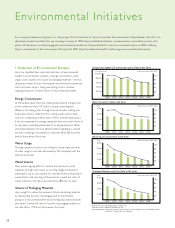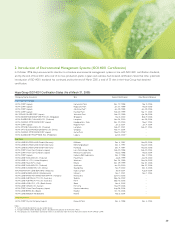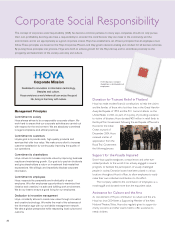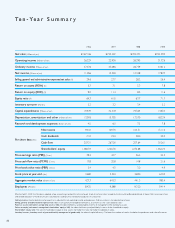Pentax 2005 Annual Report Download - page 26
Download and view the complete annual report
Please find page 26 of the 2005 Pentax annual report below. You can navigate through the pages in the report by either clicking on the pages listed below, or by using the keyword search tool below to find specific information within the annual report.
R&D and New Businesses
1. Technical Innovation in
Information Technology
The foundation of Hoya’s Information Technology field is a range of
products for which Hoya holds a high market share, including mask
blanks, photomasks for large-scale LCD panels, aspherical lenses, and
HDD glass disks. In each of these areas, Hoya must manage two
critical issues. First, Hoya must build a strong foundation for its business
by developing next-generation technologies and products ahead of
the competition. Second, it must strive to continuously develop these
businesses, seeking to acquire as soon as possible those new
technologies that will instantaneously make existing technologies a
thing of the past.
In the mask blank business, electron beam and extreme ultraviolet
(EUV) light sources are in the spotlight as the next-next-generation
technologies for lithography. Hoya completed its basic research and
development for photomask technologies compatible with electron
beam and EUV lithography, and is supplying trial masks for use in
etching tests to etching equipment manufacturers and IC device
manufacturers. At the same time, it is working to develop an
alternative technology using nano-imprint lithography techniques*1.
A number of issues related to next-generation lithography must still
be resolved, but as a leading manufacturer of mask blanks, Hoya will
continue to address the challenges posed by the need for technical
innovation.
Against the backdrop of the constant enhancement of digital
imaging technologies seen in digital cameras and camera-equipped
mobile telephones, optical lenses are expected to have a higher level
of performance than ever before, as well as improved miniaturization.
Hoya continues to grow along with the digital optical industry, by
developing ultra-precise molding technologies for highly refractive
materials and low dispersion glass materials that further boost the
optical performance of aspherical lenses.
The perpendicular magnetic recording method*2, which will allow
for data recording density to exceed the limitations of previous
longitudinal recording methods, is about to reach the moment of
practical introduction for small-size HDD glass disks. Hoya is
proceeding with plans to establish mass production of a first-
generation perpendicular magnetic recording glass disk, and is
dedicated to contributing to further growth in the HDD market.
2. Growth in the Eye Care Field
Hoya has attempted to achieve steadily growing profit through a
balanced business portfolio consisting of two main foundations—
the high-growth but high-risk Information Technology field and the
more mature Eye Care field, which focuses on consumables.
However, the steep growth of the digital consumer electronics
market over the past few years has tipped the balance in favor of
the Information Technology field, so the second major challenge
facing Hoya is increasing sales in the Eye Care field to ensure
steady overall growth.
Eyeglasses have been used to improve vision for many years
now, but Hoya continues to push the boundaries of technical
innovation by actively introducing a variety of technologies, from
materials development through optics design and lens coatings.
Hoya has focused R&D on the development of new lens materials
and optics designs, seeking to produce lighter and high-strength
plastic materials and highly functional coatings. Hoya is determined
to continue to lead the market by introducing clearer and more
convenient eyeglass lenses.
The market for IOLs, which are used in the treatment of
cataracts, is expected to show more growth. Following the
development of soft hydrophobic acrylic IOLs, Hoya produced an
injector system that greatly simplified surgical procedures, and a
yellow-type IOL that helped patients regain a more natural color
tone to their vision. Hoya will continue to augment its sales efforts
around the world, and is actively considering mergers and
acquisitions as one element in this growth strategy.
Hoya originally achieved its niche market growth as a “big fish in a small pond” by differentiating its core products and services through the
application of innovative technologies and business models. However, with the globalization of markets and competition, and the continued
growth in the scale of Hoya’s business, Hoya understands the need to maintain even larger, faster growth in the future. In its commitment to
future growth, Hoya is tackling the following three particularly important challenges.
Notes:
*1. Nano-imprint lithography techniques are a practical application of a nano-scale press molding process. With these microscopic processing techniques, a mold with an extremely
fine pattern structure is pressed into a resist on the surface of a silicon wafer, creating a pattern in the resist. They enable processing as precise as several tens of nanometers.
They are expected to be suitable for mass production at low cost, and offer time savings in the pattern transfer process.
*2. Using this method, when data are written to an HDD, the recording head magnetizes in a direction perpendicular to the layer, rather than in the usual horizontal direction.
This technique allows for greater recording density.



